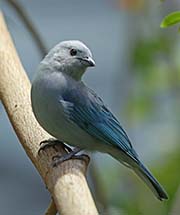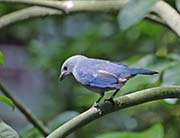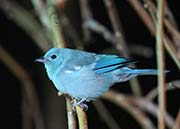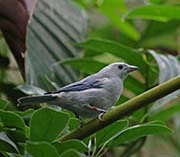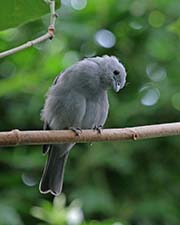Blue-gray Tanager - Thraupis episcopus
| Length | |
| Weight | |
| Clutch Size | |
| Chicks at birth | |
| IUCN Conservation Status | |
Continents: |
The Blue-gray Tanager is found from Mexico south to Bolivia and northern Brazil. There are 13 subspecies of this bird, and the plumage coloration varies between the subspecies. Some Blue-gray Tanagers are bluer, others grayer and the wing coverts can be tinged in lavender, blue, or white. Bills are thick. Juveniles are duller in color.
Diet: Their diet mainly consists of fruit and insects. They forage for the fruit in the upper level of trees but will occasionally eat fallen fruit if food is scarce. They will also occasionally eat flowers and their nectar.
Courtship: They live in pairs and will form single-species flocks in some regions. When one takes flight, the other mate will usually follow but they do not fly side-by-side. They also do not perch together when resting. They establish nesting territories after agile, darting aerial contests.
Nesting: Blue-gray Tanagers build a deep cup shaped nest which is usually above the ground in a tree fork or a bush. Nests have also been found on the ground and under shed roofs. Both sexes build the nest which usually consists of rootlets, green moss, grass, ferns, leaves and fine vegetable fibers for the lining. The female lays and incubates 1-3 almost white to gray thickly mottled eggs on consecutive days. Both parents feed the chicks.
Habitat and Range: Blue-gray Tanagers prefer semi-open habitats and will be found in lowland forests, semi-open forests edges, and trees in cultivated lands, savannas and human settlements.
Vocalization: The male's song is a series of very squeaky, squealed, or drawn out notes. The notes will typically alternate 1 or 2 high-pitched notes with 1 or 2 moderate pitched notes. The patterns may be repeated or changed with every series. Females sing a briefer and weaker song.
Plumage/Molt No alternate plumage and molt annually.
Migration: Non-migratory.
Tongue/feet: Legs and feet are gray or blue-gray.
Bibliography:
- Isler, Morton L. and Isler, Phyllis R., The Tanagers: Natural History, distribution, and Identification,Smithsonian Institution Press, Washington D.C., 1987
- http://en.wikipedia.org The Free Encyclopedia, Accessed December, 2012

